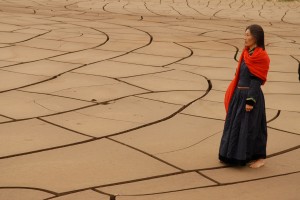The Two Horses of Genghis Khan (Byambasuren Davaa, 2009): Germany/Mongolia
Reviewed by Guy Dolev. Viewed at Mann Chinese Theater 1, AFI Film Festival 2009, Hollywood, California.

Continuing in the vein of The Cave of the Yellow Dog (2005) and The Story of the Weeping Camel (2003), Oscar-nominated Mongolian-German filmmaker, Byambasuren Davaa, blends documentary with production styles typically associated with drama in her unique portrait of modern-day Mongolia. The film’s title, The Two Horses of Genghis Kahn, refers to an ancient Mongolian song, which is presumed to have been lost.
In peaceful quietude, this story is told by a young woman, Urna, in letters and prayers to her grandmother who had to relinquish many of her possessions in Mao Zedong’s cultural revolution including her beloved horse-head violin, which had the chorus of the song engraved upon its neck. Now, only the neck and head of the instrument remain, the body of the violin being destroyed in the chaos, as Urna sets out to find the lost verses of the ancient song, “The Two Horses of Genghis Khan,” by retreating to Outer Mongolia.
Urna’s dream is to make a final gift to her grandmother and fulfill her sense of accomplishment by returning with the complete song and to sing it with a modern Mongolian orchestra. With confidence that the rural-types in the outskirts of the land will have a better remembrance of the song than the hustling and bustling citizens of the inner-city, Urna’s journey takes us on a beautiful, untraveled path to a land rarely seen on film. Along the way Byambasuren Davaa shows us the trash-gleaners of the city, and Urna’s quest to have the violin’s head and neck restored with a new body, by a master luthier.
The silence of the film is only broken by the gentle songs sung along the way to discovering the music. In this film, we get a sense of a lost world and its uncontacted inhabitants. Preserving their ancient ways, their songs, their horse races, stand in great contrast to the commotion of homogenous inner-city life.
Truly, the film is a mixture of documentary and other styles, though it never defines itself by the rigid structural classifications we like to ascribe to such things in Western culture. Byambasuren’s films show a masterful eye at work, realizing stunning stories of life that unfold naturally and cinematically all at once. For its tranquil, meditative music and serene landscape photography alone, the film preserves a way of life that is quickly vanishing from this earth.
About this entry
You’re currently reading “The Two Horses of Genghis Khan (Byambasuren Davaa, 2009): Germany/Mongolia,” an entry on Student Film Reviews
- Published:
- 11.09.09 / 1pm
- Category:
- AFI Filmfest 2009, Films
No comments
Jump to comment form | comments rss [?] | trackback uri [?]